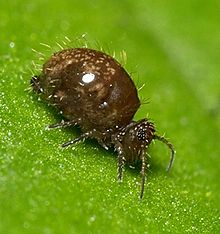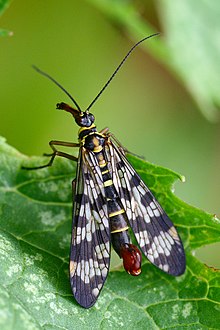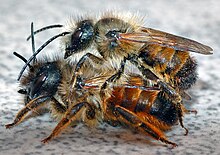Insect of the year
The Insect of the Year has been proclaimed annually in Germany since 1999 by the Insect of the Year Board of Trustees founded by Holger Heinrich Dathe . The campaign is coordinated by the Senckenberg German Entomological Institute in Müncheberg .
Since 2000 Austria has had its own insect of the year. In the Board of Trustees for Austria's Insect of the Year, among others, Austrian specialist societies for entomology and the Austrian Nature Conservation Union participated . Since 2005 the election has been carried out jointly for Germany and Austria, since 2009 jointly for Germany, Austria and Switzerland.
Mostly known, very noticeable or interesting insects are chosen. The insect of the year is made known to the public through press work and is described in more detail in a leaflet. The purpose of the campaign is to point out the dangers and benefits of the world of small animals for humans, similar to other campaigns in the area of Nature of the Year .
Insects of the year
Germany (1999-2004)
| year | German name | scientific name | Illustration |
|---|---|---|---|
| 1999 | Common lacewing | Chrysoperla carnea | |
| 2000 | Shiny gold rose beetle | Cetonia aurata | |
| 2001 | Flat stomach | Libellula depressa | |
| 2002 | Brimstone butterfly | Gonepteryx rhamni | |
| 2003 | Field cricket | Gryllus campestris | |
| 2004 | Grove hover fly | Episyrphus balteatus |
Austria (2000-2004)
| year | German name | scientific name | Illustration |
|---|---|---|---|
| 2000 | Viennese night peacock butterfly | Saturnia pyri | |
| 2001 | Alpine buck | Rosalia alpina | |
| 2002 | Swelling maids (3 types) |
Cordulegaster boltonii , Cordulegaster bidentata , Cordulegaster heros |
|
| 2003 | European Bach-like | Osmylus fulvicephalus | |
| 2004 | Sail butterfly | Iphiclides podalirius |
Germany and Austria (2005-2008)
| year | German name | scientific name | Illustration |
|---|---|---|---|
| 2005 | Stone bumblebee | Bombus lapidarius | |
| 2006 | Seven-point ladybug | Coccinella septempunctata | |
| 2007 | Knight bug | Lygaeus equestris | |
| 2008 | Esparsette ram | Zygaena carniolica |
Germany, Austria and Switzerland (since 2009)
| year | German name | scientific name | Illustration |
|---|---|---|---|
| 2009 | Common bloodhopper | Cercopis vulnerata | |
| 2010 | Ant lion | Myrmeleon formicarius | |
| 2011 | Great notch ant | Formica exsecta | |
| 2012 | Stag beetle | Lucanus cervus | |
| 2013 | Banded river quiver fly | Rhyacophila fasciata | |
| 2014 | Gold shield fly | Phasia aurigera | |
| 2015 | Silver-green bluish | Polyommatus coridon | |
| 2016 |
Dark brown spherical diver (does not belong to the insects in the narrower sense, but to the hexipedes ) |
Allacma fusca | |
| 2017 | European praying mantis | Mantis religiosa | |
| 2018 | Common scorpion fly | Panorpa communis | |
| 2019 | Red mason bee | Osmia bicornis | |
| 2020 | Black and blue oil beetle | Meloe proscarabaeus |
Board of Trustees Insect of the Year
Every year the Insect of the Year Board of Trustees selects an insect from numerous proposals and announces the decision at a press conference.
Initial composition
Initially, the board of trustees only determined the insect of the year for Germany. The following institutions participated in the election of the first insect of the year ( Common Lacewing , 1999):
- German Entomological Institute , Eberswalde. Chairman of the Board of Trustees: Holger Heinrich Dathe
- Federal Expert Committee on Entomology in the German Nature Conservation Union
- German Society for General and Applied Entomology
- Entomofaunistic Society, Dresden
- House of the Forest, Forestry Office, Königs Wusterhausen
- Landesforstanstalt Eberswalde
- Ministry of Food, Agriculture and Forests of the State of Brandenburg, Potsdam
- Forest school, Eberswalde Forestry Office
Current composition
Since 2005, the poll for insect of the year has been carried out jointly for Germany and Austria, since 2009 jointly for Germany, Austria and Switzerland. Accordingly, experts from Austria and Switzerland also took part in the vote in the Board of Trustees. The following institutions are currently (2018) represented on the Board of Trustees:
Germany
- Senckenberg German Entomological Institute , Müncheberg. Chairman of the Board of Trustees: Thomas Schmidt
- Federal Expert Committee on Entomology in the German Nature Conservation Union
- Federal Association of German Ant Conservation Centers
- German Society for General and Applied Entomology
- Entomofaunistic Society, Dresden
- Julius Kühn Institute , Federal Research Institute for Cultivated Plants
- Munich Entomological Society
- Museum für Naturkunde Berlin - Leibniz Institute for Evolution and Biodiversity Research
- German Forest Protection Association
- Sparkasse Barnim , Eberswalde
Austria
- Austrian Entomological Society , Vienna
- Nature Conservation Union Austria , Salzburg
Switzerland
- Swiss Entomological Society
Board of Trustees for Austria's Insect of the Year
In Austria a separate insect of the year was chosen for the years 2000 to 2004. Representatives from the following institutions participated in the Board of Trustees for Austria's Insect of the Year (in the order of entry, status 2001):
- Austrian Entomological Society
- Institute for Nature Conservation, Styria
- Austrian Nature Conservation Association
- Association of Austrian Entomologists
- Austrian Society for Entomofaunistics
- Federal Office and Research Center for Agriculture
- a state museum (a different federal state annually)
- Federal Ministry for Agriculture, Forestry, Water and Environment
Selection criteria
For the election of the Insect of the Year in Austria (from 2000) a working group of the Austrian Entomological Society put together the following selection criteria for the Austrian Board of Trustees:
- The species should be typical for Austria, possibly endemic there or name with reference to Austria
- Attractive, "photogenic" appearance (minimum size, easily recognizable, colorful or high-contrast)
- Awareness (well-known German name, at least biology teachers should know the species)
- Availability of very good photos for press articles, if possible also film material
- The biology of the species should be sufficiently known, easy to represent and explainable in school lessons
- Good image: interesting biology, not a threat or nuisance , not a dangerous way
- Inhabiting special habitat type : reference species for the habitat , possibly living on endangered plants or in endangered biotopes , habitat protection should be possible
- Particular hazard ( red list , legally protected, "worth a rescue attempt", possibly formerly widespread, relevant for the EU )
- Short-term feasibility of the accompanying program (e.g. with press work, brochures, postage stamps)
- The species should enable enthusiasm and motivate other institutions to participate (nature conservation associations, media, schools, ministries, etc.)
- The individual should also be able to do something, e.g. B. Habitat protection in your own garden
- Chance to use this insect to educate people and clear up misunderstandings
- The species should be interesting, raise questions and have unique properties
- Funding opportunities from nature conservation organizations, ministries and authorities or the EU
- Objectivity of the selection by counting how many of the aforementioned criteria apply
Johannes Gepp from the Institute for Nature Conservation in Graz reported that in the first election for the year 2000, numerous proposals failed due to the criterion “availability of very good photos”. The Viennese peacock butterfly fulfilled many selection criteria, including: reference to Austria (already described by Austrian entomologists in 1775, “ Vienna ” in the name), beautiful drawing of the wings, special features (largest butterfly in Central Europe, conspicuous green caterpillars ), threat for various reasons , sharp decline in the population, protection options. Nevertheless, the selection from a total of 31 proposals proved to be complicated. The Viennese night peacock butterfly could only be elected with a relative majority after several voting rounds and months of deliberation. The second choice ( Alpenbock , 2001) focused on the criterion that the species is threatened and strictly protected throughout the EU ( Fauna-Flora-Habitat Directive ).
Web links
- Insect of the year senckenberg.de
- Insect of the year naturschutzbund.at (for Austria)
- Insect of the year 2017 Swiss Entomological Society
Individual evidence
- ^ First insect of the year for Germany and Austria (2005): Steinhummel (PDF).
- ^ First insect of the year for Germany, Austria and Switzerland (2009): Gemeine Blutzikade (PDF).
- ↑ Flyer on all insects of the year in Germany since 1999 senckenberg.de
- ↑ Praying Mantis is Insect of the Year 2017 scinexx.de
- ↑ The most dangerous thing is the name: The common scorpion fly is “Insect of the Year 2018” nabu.de.
- ↑ Rust- red mason bee is the insect of the year 2019 kurier.at
- ↑ First insect of the year in Germany (1999): Green Lacewing (PDF).
- ↑ Insect of the Year Board of Trustees senckenberg.de
- ↑ a b c Johannes Gepp: Austria's insect of the year - a way of entomological public relations. Entomologica Austriaca 2/2001, pp. 3–6 ( PDF ).




























